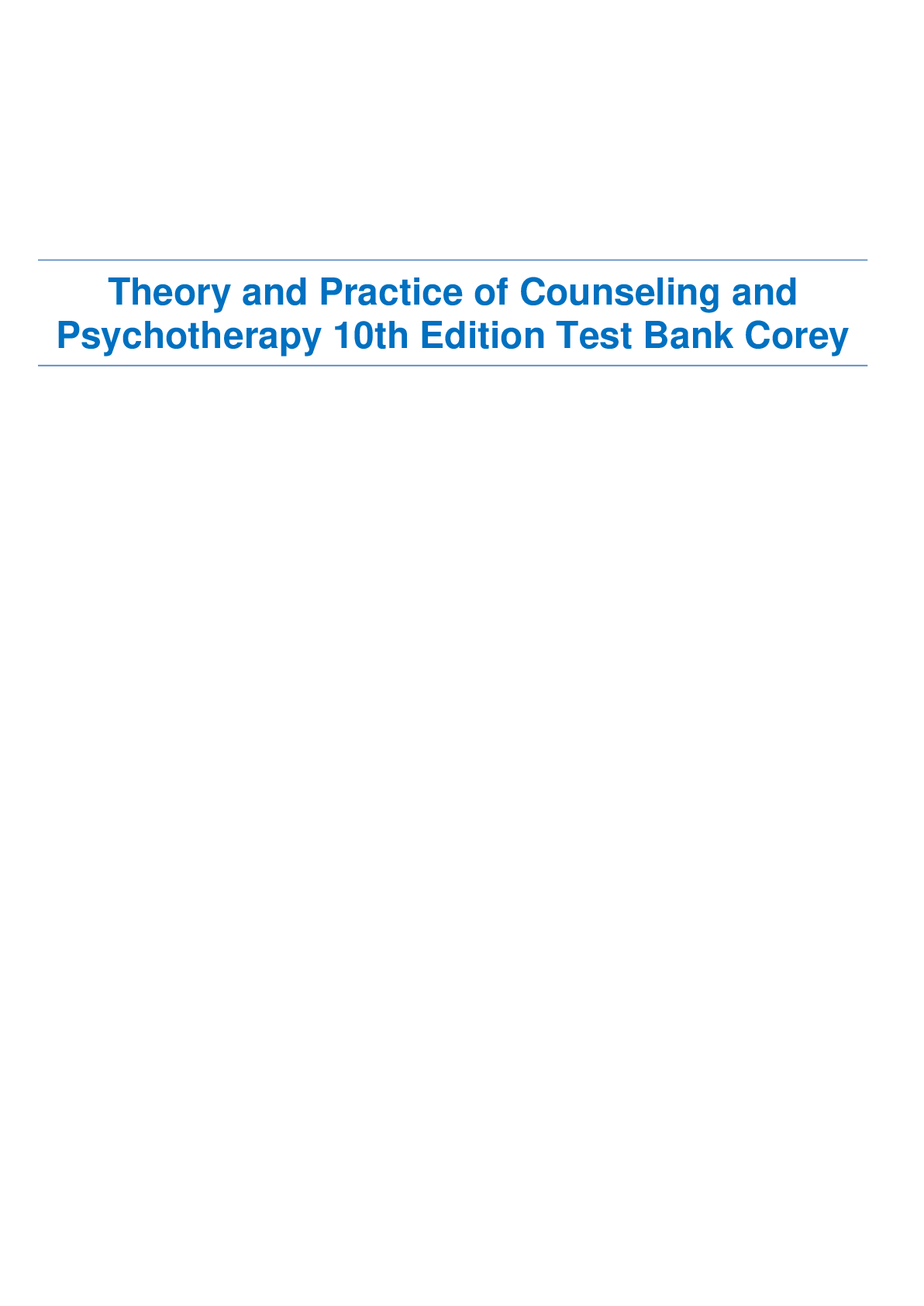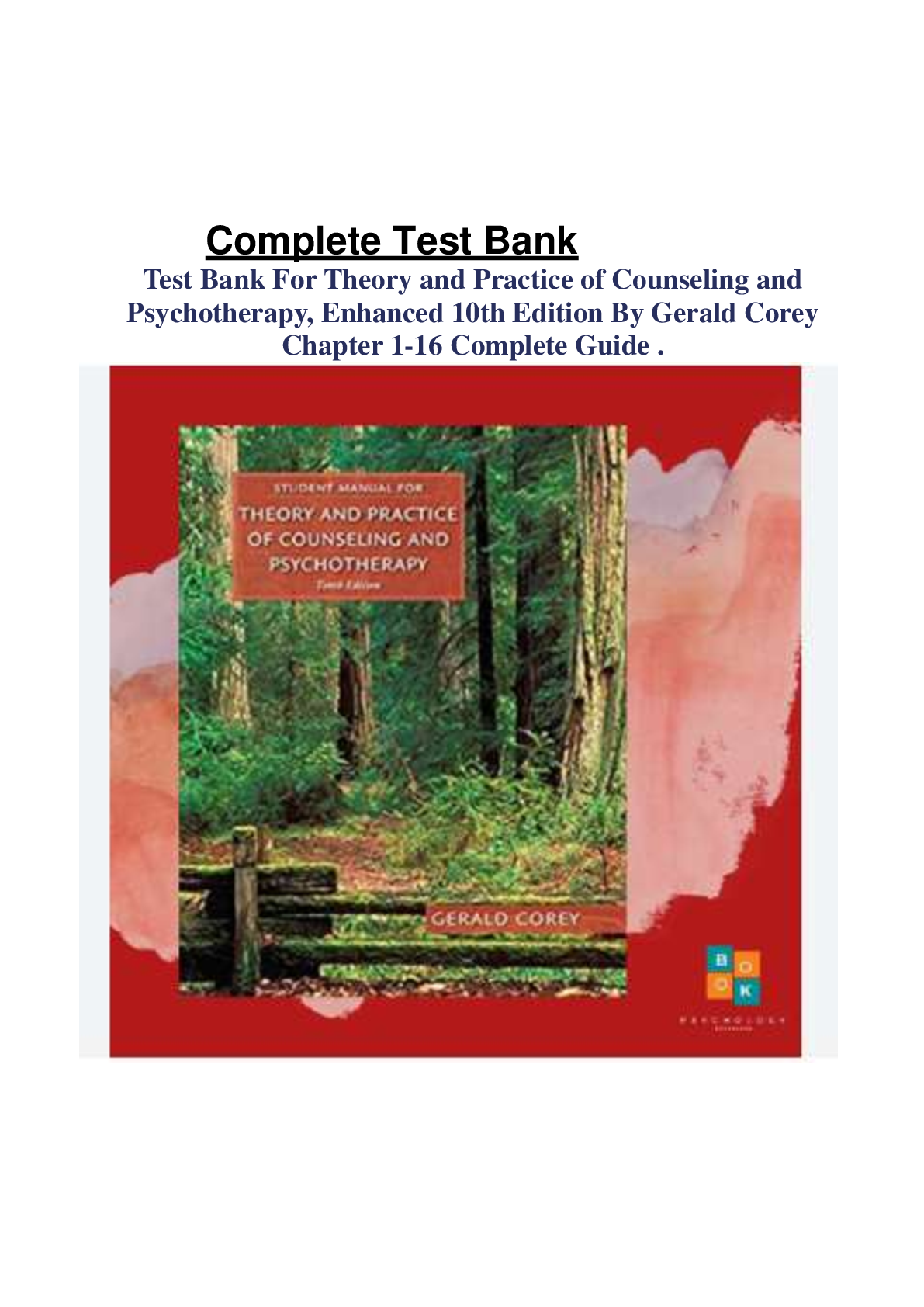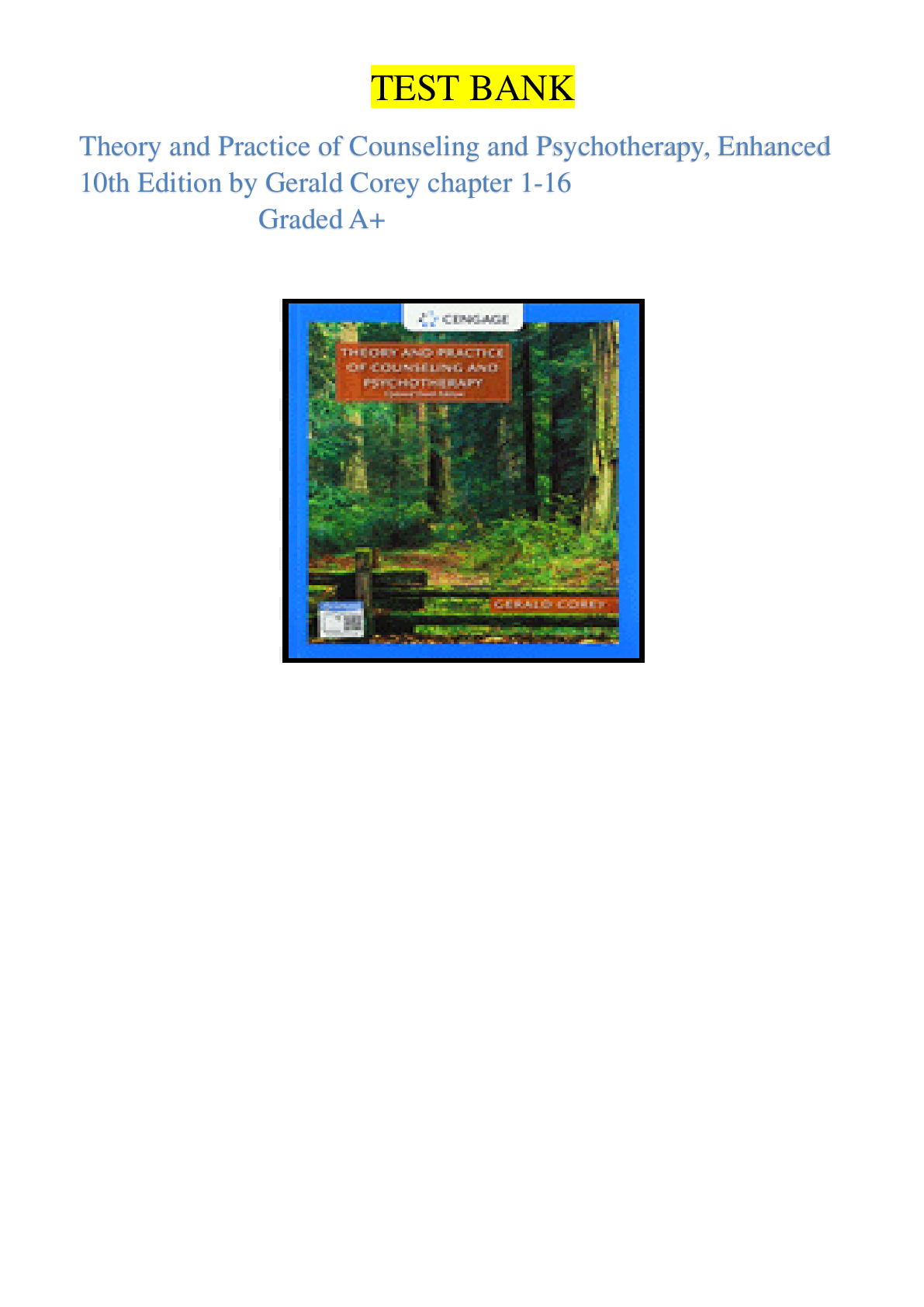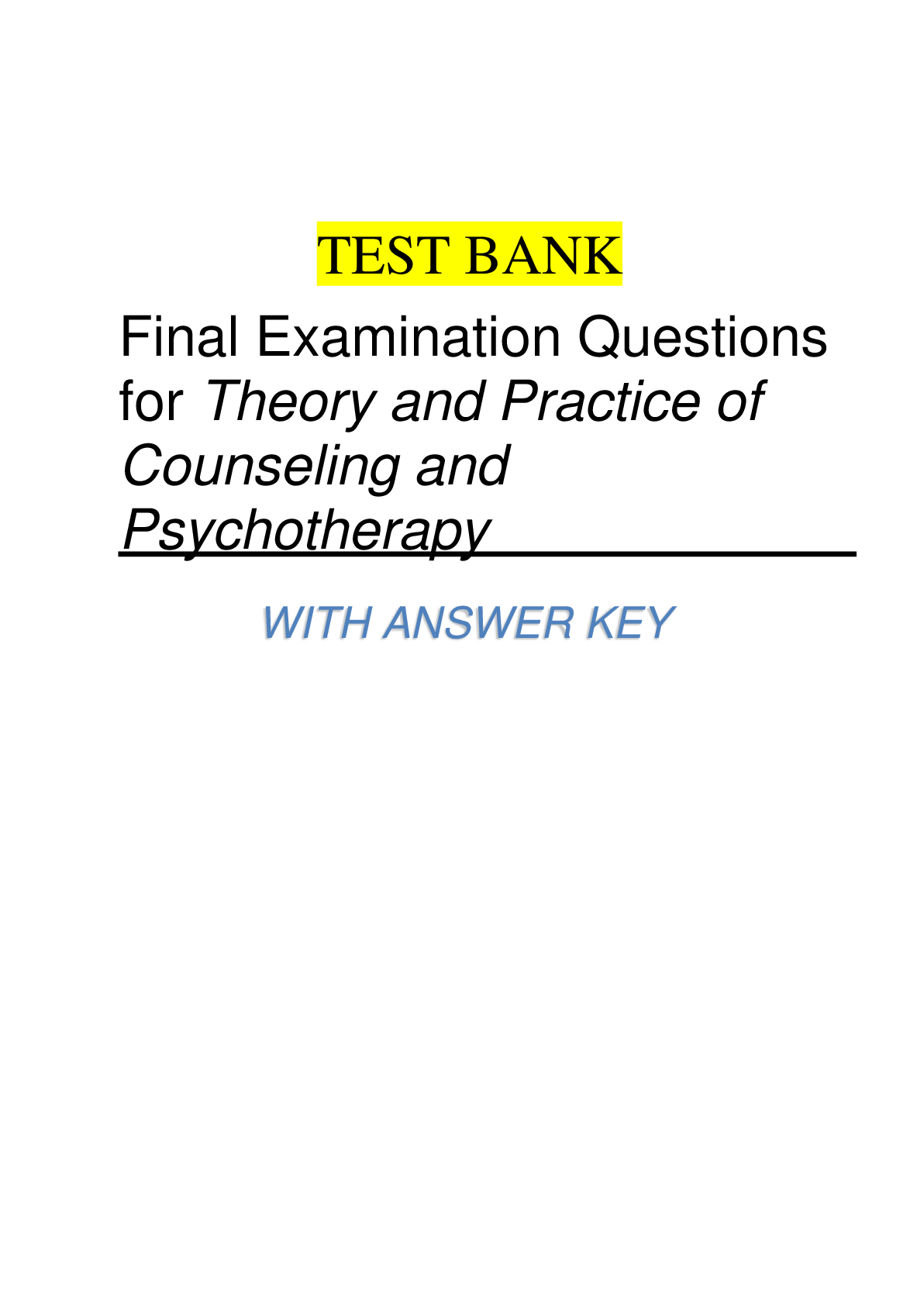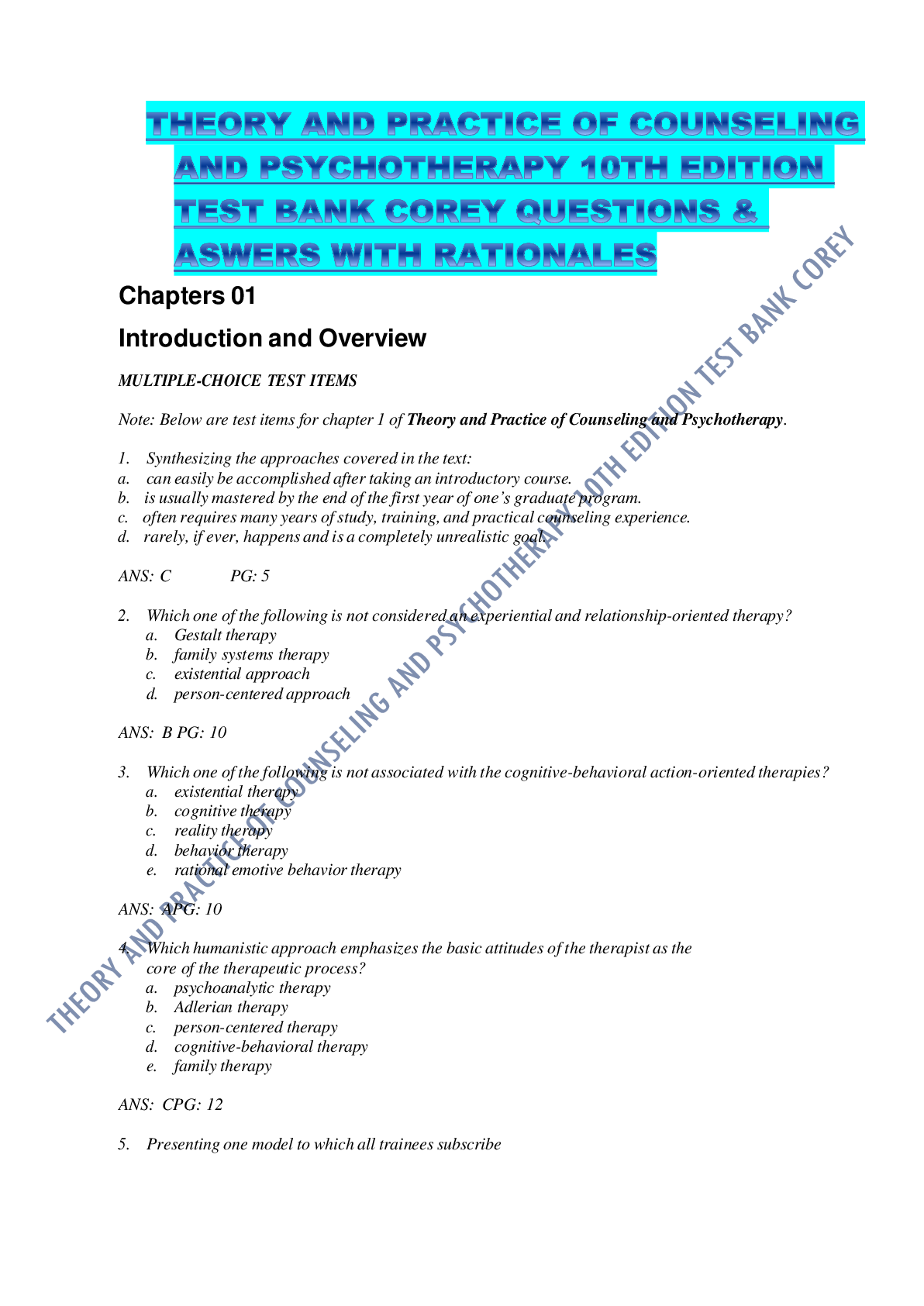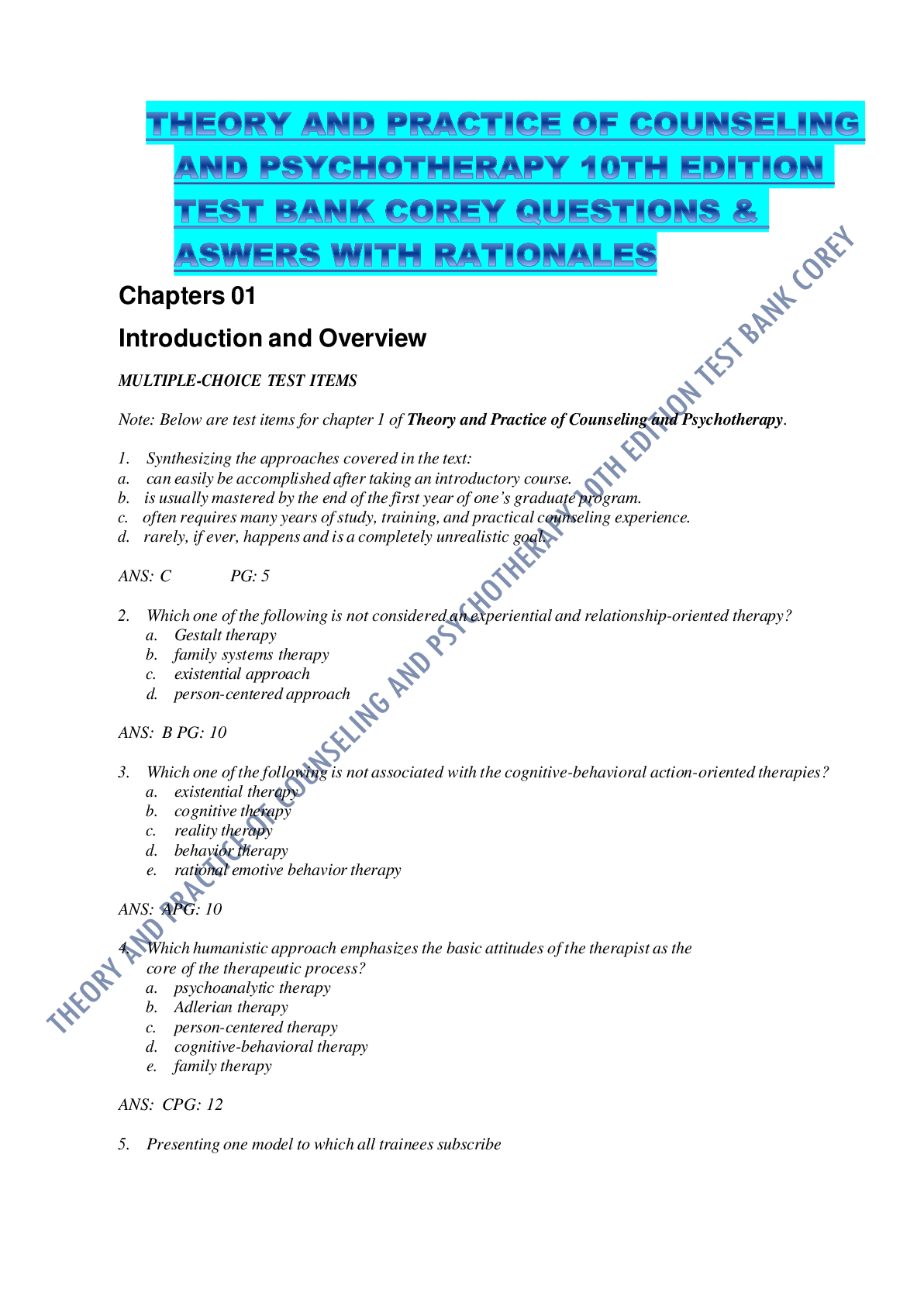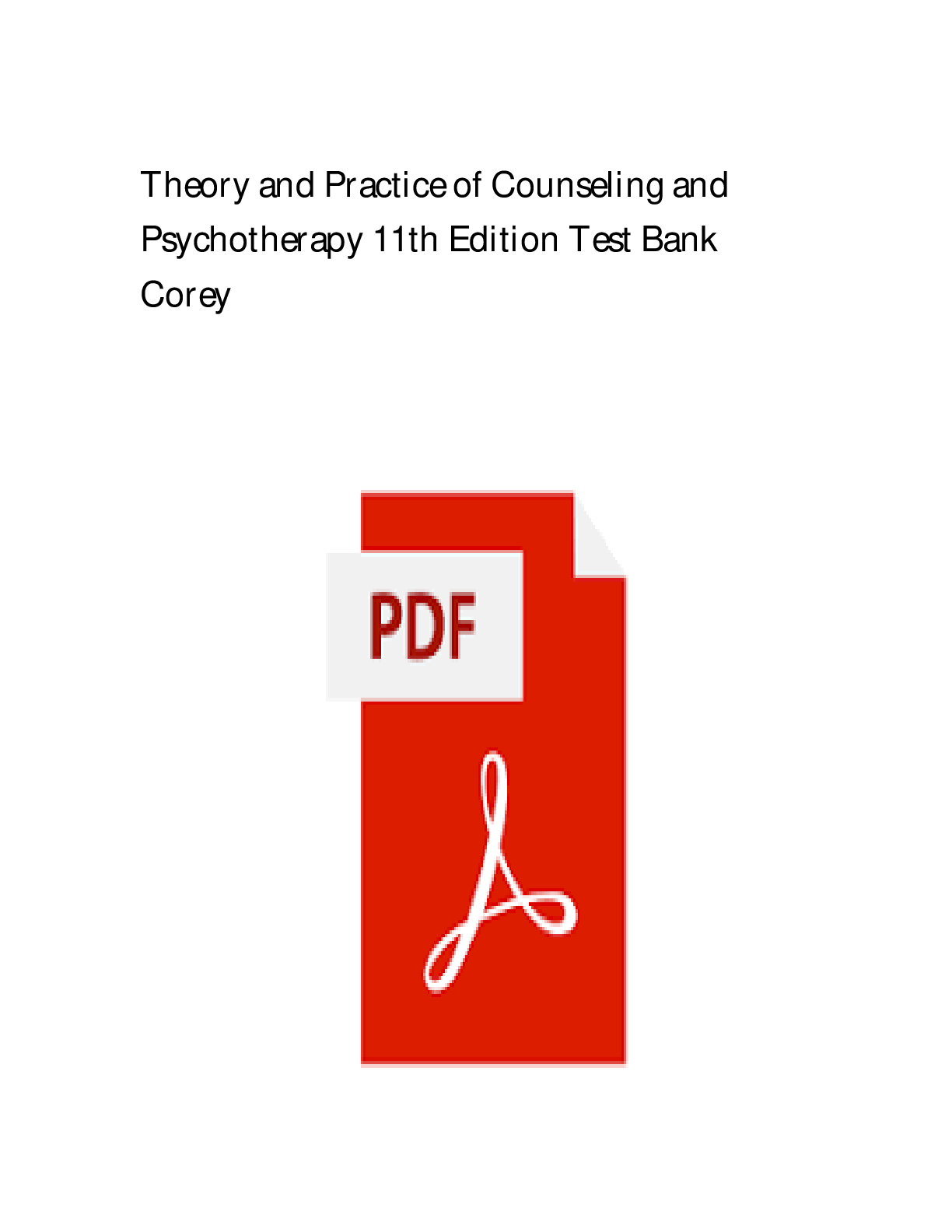Sociology > EXAM > Fisher College: Practice of Counseling and Int HS202-W1-202100: Midterm Exam. Graded A (97%) (All)
Fisher College: Practice of Counseling and Int HS202-W1-202100: Midterm Exam. Graded A (97%)
Document Content and Description Below
1. Practice of Counseling and Int HS202-W1-202100 2. Tests/Quizzes 3. Take Test: Midterm Exam Course Practice of Counseling and Int Test Midterm Exam Status Completed Attempt Score 97.2 out of 1... 00 points Time Elapsed 1 hour, 56 minutes out of 2 hours Take Test: Midterm Exam Test Information Description Instructions Timed Test This test has a time limit of 2 hours.You will be notified when time expires, and you may continue or submit. Warnings appear when half the time, 5 minutes, 1 minute, and 30 seconds remain. Multiple Attempts Not allowed. This test can only be taken once. Force Completion This test can be saved and resumed later. The timer will continue to run if you leave the test. Your answers are saved automatically. QUESTION 1 1. Professional helpers can be distinguished from non-professional helpers by which of the following? a. existence of an accrediting body that governs training, credentialing, and licensing of practice b.identification with a professional organization c. adoption of an ethical code and standards of practice d.all of the above 1.85 pointsQUE ST ION 2 1. Professional helping is described by all EXCEPT which of the following? It addresses the thoughts, feelings, actions, and social systems of clients. It is almost always multicultural in nature. It is premised on a basic acceptance of all clients regardless of their behaviors. It may necessitate strong persuasion and influence if the client is resistant or reluctant. 1.85 points QUE ST ION 3 1. The four conditions under which helping is most likely to occur include: someone trained and/or capable as a helper, someone willing to offer help, a setting conducive to helping, and help offered by a professional versus a paraprofessional helper. a client seeking help a reluctant client who has been mandated to seek help. a client who denies needing or wanting help. 1.85 points QUE ST ION 4 1. Cultural affiliations may lead a distressed individual to do which of the following? a. not seek help from a helping professional b.seek guidance from tribal elders, or religious or spiritual leaders c. turn to family confidants d.all of the above 1.9 points QUE ST ION 5 1. Which of the following is LEAST likely to describe helping in school settings? a. Much of the high school counselor’s work is with the teaching staff ratherthan individual students. b.The current force of school counseling is in comprehensive programs that focus on primary prevention and healthy development for all students. c. The ASCA National Model focuses counselor efforts on achievement and educational needs. d. Elementary helpers emphasize the total school environment rather than individual helping of children. 1.85 points QUE ST ION 6 1. Current issues related to helping in college settings include all EXCEPT which of the following? a. more severe psychopathology among students including chronic mental illness b.a decrease in the number of third culture kids (TCK) and multiracial and international students c. helpers assigned to academic advising, residences, and career services d.an increase in the use of technology to meet student helping needs 1.9 points QUE ST ION 7 1. Which of the following accurately depicts the roles of helpers in community settings? a. They may become involved in community advocacy efforts and direct community intervention. b. They often conduct psychotherapy with individuals, families, and/or groups. c. They are employed in the widest variety of employment settings relative to other helpers. d. All of the above are accurate.1.9 points QUE ST ION 8 1. The communication of accurate empathy promotes all EXCEPT which of the following? a. decreased client exploration b.decreased premature client termination c. increased client sense of safety d.increased client sense of being understood 1.9 points QUE ST ION 9 1. Some research suggests that counselors are perceived more positively when they engage in__________ self-disclosure. a. high levels of b.moderate levels of c. low levels of d.no 1.9 points QUE ST ION 10 1. Communication patterns are impacted by which of the following? a. race b. culture c. ethnicity d.b and c only e. none of the above 1.9 points QUE ST ION 11 1. Mirroring refers to: a. The helper reflecting exactly how he or she is feeling b.The helper repeating back what the client is saying and doing c. The helper reflecting the facial expressions of the helpee d.All of the above 1.9 pointsQUE ST ION 12 1. Issues related to confidentiality and privacy in the college setting have become more complex due to the advent of __________. outreach programming support groups psychoeducation sessions online counseling 1.9 points QUE ST ION 13 1. According to Vacc and Loesch (2000), the three major activities undertaken by helpers working in religious settings include all EXCEPT __________. mood management counseling referrals to other professionals bereavement counseling marriage and family counseling 1.9 points QUE ST ION 14 1. Which of the following is NOT true with respect to helping in industrial and employment settings? The private sector is considered to be the new frontier for helping services. Outplacement services were initiated in response to the association established between workplace stress and infectious disease. Outplacement helpers are often those who have firsthand experience in an industry setting. Employment assistance programs address issues such as substance abuse and couple and family relationship issues. 1.9 points QUE ST ION 151. Helping professionals working with members of the military deal with a wide range of issues including all of the following EXCEPT: stress management and post-traumatic stress substance abuse parenting employment loss 1.9 points QUE ST ION 16 1. The concept of resiliency is highly salient to professional helping practice because it promotes: preparedness to address global challenges such as terrorism. coping with everyday stressors. transfer of hope and optimism to clients. all of the above. 1.85 points QUE ST ION 17 1. The individual credited with the genesis of the personcentered approach is Norcross. Skinner. Freud. Rogers. 1.9 points QUE ST ION 18 1. Which of the following is LEAST likely to be true about clients who feel cut off from themselves and their experiences and are seeking a sense of wholeness? They missed out on caring communication and healthy attachment to a caregiver in early life. They have developed narratives (or stories) and conclusions about themselves that are both organized and flexible. They have not achieved enough brain integration to regulate emotions effectively. They have had their experiences and expressions of self denied or judged. 1.9 points QUE ST ION 191. Which of the following statements does NOT accurately depict helper empathy? It sounds as though it has been really unsettling for you to change schools as a result of your parents’ divorce. You seem really hurt and confused about the break-up with your girlfriend. I’m so sorry to hear about the loss of your grandmother. I imagine that it was pretty difficult to break this news to your family. 1.9 points QUE ST ION 20 1. Generally, the most productive use of helper disclosure occurs when the focus is on the helper’s own issues and facts about the helper’s role. the helper’s own issues and reactions to the client. facts about the helper’s role and the helper’s reactions to the helping relationship. the helper’s reactions to the client and to the helping relationship. 1.9 points QUE ST ION 21 1. Identify the most probable sequence of helping experiences with a new client who has a history of discrimination, oppression, or betrayal. client guardedness, testing of helper, sense of safety, sense of trust, disclosure by client disclosure by client, sense of safety, sense of trust, client guardedness, testing of helper testing of helper, sense of trust, client guardedness, disclosure by client, sense of safety sense of safety, sense of trust, disclosure by client, client guardedness, testing of helper 1.9 points QUE ST ION 22 1. When a client engages in frequent topic shifts during the first few sessions, this may be an indication ofanxiety related to the helping process. a need to exert some control over the helping process. both a and b. neither a or b. 1.9 points QUE ST ION 23 1. Which of the following does NOT apply to the concept of ritualized patterns of communication? 1.85 points QUE ST ION 24 1. Four potential communication barriers in cross-cultural helping that have been identified by Pedersen and Ivey (1993) include: verbal and nonverbal language problems, interference from preconceptions and stereotyping, erroneous evaluation, and __________. arrogance stress indifference inflexibility 1.9 points QUE ST ION 25 1. When a communication mismatch occurs in the context of a cross-cultural helping dyad, there is an increased risk of premature termination of the session by the client. inability of the helper to establish rapport with the client. cultural oppression of the client. all of the above. situation specific suspension of previous style of interaction idiosyncratic to the individual involved trademark interaction style1.9 points QUE ST ION 26 1. Perpetuation of gender roles is damaging to: men. women. both men and women. none of the above. 1.9 points QUE ST ION 27 1. Research suggests that many helpers have: no opportunity to work with LGBTQ clients. only worked with LGBTQ clients. prejudicial beliefs that affect the therapeutic relationship with LGBTQ clients. no access to support and competency training for working with LGBTQ clients. 1.9 points QUE ST ION 28 1. All of the following are common communication problems helpers experience with disabled clients EXCEPT: helpers may fear to say the wrong thing. helping sessions may be terminated prematurely. helpers may struggle with boundary crossing with clients. helpers may use biased language with clients. 1.9 points QUE ST ION 29 1. An important differentiation between immigrant and refugee clients is: immigrants have migrated voluntarily and refugees have been forced to migrate. immigrants are pushed out of their country and refugees are pulled to their new country. immigrants have never suffered traumatic experiences at home, whereas refugees have. immigrants are better able to afford counseling, whereas refugees often arrive here in poverty. 1.9 points QUE ST ION 301. With respect to helper-induced silence, unintentional silence is often used as a reflection of his or her tendency to hide, withhold, and self-protect. unsystematically when at a loss for words. to deliberately reduce helper activity and to transfer responsibility to the client. to avoid interfering with or impeding the client’s momentum. 1.9 points QUE ST ION 31 1. The judicious and deliberate use of silence by the helper may be effective in pacing the interview. communicating compassion and caring. helping the client develop insight into defense mechanisms. accomplishing all of the above. 1.9 points QUE ST ION 32 1. Attentiveness is communicated primarily through verbal responses. facial expressions and eye contact. bodily positions and movement. all of the above. 1.9 points QUE ST ION 33 1. The three core conditions of helping are central to the therapeutic process and include all EXCEPT which of the following? genuineness or congruence accurate empathyattentive listening positive regard 1.9 points QUE ST ION 34 1. Regional and cultural variances are evidenced in a preference for direct eye contact when speaking among __________. Native Americans Euro-Americans inner-city African American youths none of the groups indicated above 1.9 points QUE ST ION 35 1. There does not appear to be much variation in __________ across cultures. facial expressions duration and directness of eye contact gestures used to convey meaning all of the above 1.9 points QUE ST ION 36 1. During interaction in the helper dyad, selective body tension generally reflects comfort with the topic being discussed. a working moment or action. blocking or holding back a feeling. discomfort with the topic or the other person. 1.9 points QUE ST ION 37 1. When a helper verbally acknowledges a topic that the client has brought up, the client will likelycontinue to develop and pursue the topic. immediately interrupt him/herself and change topics. cut the topic short without fully pursuing it. become silent. 1.9 points QUE ST ION 38 1. The process of choosing whether to focus on a client’s cognitive or affective response is called attentiveness. differentiation. verbal following. non-verbal response. 1.9 points QUESTION 39 1. Responding primarily to cognitive content can limit the helper’s understanding of the client’s problem. the client’s ability to recognize the influence of their emotions on their behaviour. the client’s ability to share his or her thinking in a non-judgemental setting. the helper’s ability to relate to the client’s family of origin patterns. 1.9 points QUESTION 40 1. What is often one of the toughest challenges for beginning helpers? listening. summarizing. applying strategies. building rapport. 1.9 points QUESTION 41 1. Which of the following is NOT a listening skill? summarization of feelings. paraphrasing.reflection of feelings. motivational interviewing. 1.9 points QUE ST ION 42 1. The _____________ is a rephrasing of the client’s previous communication that neither adds nor detracts from the message. summary paraphrase reflection of content none of the above 1.9 points QUESTION 43 1. Reflection of feelings is important because it is used to convey basic empathy. affirms client feelings instead of negating or judging them. helps clients with a history of oppression feel seen and respected. all of the above. 1.9 points QUESTION 44 1. Which of the following is NOT true about summarization? it forms a cohesive picture of the client’s messages. it focuses a client who is less verbal. it helps identify themes. it is a common skill in terminating with a client. 1.9 points QUESTION 45 1. According to Teyber (2006), which of the following affect constructions would most likely manifest in a client whose family or culture discouraged expression of anger? sadness-anger-shame sadness-anger-guiltanger-sadness-sha anger-sadness-guilt 1.9 points QUE ST ION 46 1. When helpers listen judgmentally, they are engaging in evaluative listening. summarizing. reflections of content. filtered listening. 1.85 points QUE ST ION 47 1. Action skills are used by helpers to establish rapport. listen to clients. affect change. challenge client’s thinking. 1.85 points QUESTION 48 1. Questioning can be uncomfortable for clients because they may feel pressured to share before they are ready. they feel they don’t have the correct answer. they were not expecting to answer questions. questions disrupt their thinking processes. 1.85 points QUESTION 49 1. While __________________ questions are recommended, there are uses for ________________ questions as well. closed; open-ended open-ended; closed focused; closed. open-ended; focused1.85 points QUE ST ION 50 1. Open-ended questions are useful for all of the following EXCEPT starting a session. encouraging client elaboration. eliciting a specific piece of information. eliciting additional information. 1.85 points QUE ST ION 51 1. To avoid using accusatory questions a help should avoid using the word what how when why 1.85 points QUE ST ION 52 1. The challenge response is used to enhance client self-awareness. promote client change. confront unhelpful thinking. both a and b. 1.85 points QUE ST ION 53 1. When formulating questions, it is important for the helper to have a clear ________ for the question. purpose expectation plan outcome 1.85 pointsSave and Submit [Show More]
Last updated: 2 years ago
Preview 1 out of 16 pages

Buy this document to get the full access instantly
Instant Download Access after purchase
Buy NowInstant download
We Accept:

Reviews( 0 )
$14.00
Can't find what you want? Try our AI powered Search
Document information
Connected school, study & course
About the document
Uploaded On
Aug 02, 2020
Number of pages
16
Written in
Additional information
This document has been written for:
Uploaded
Aug 02, 2020
Downloads
0
Views
155

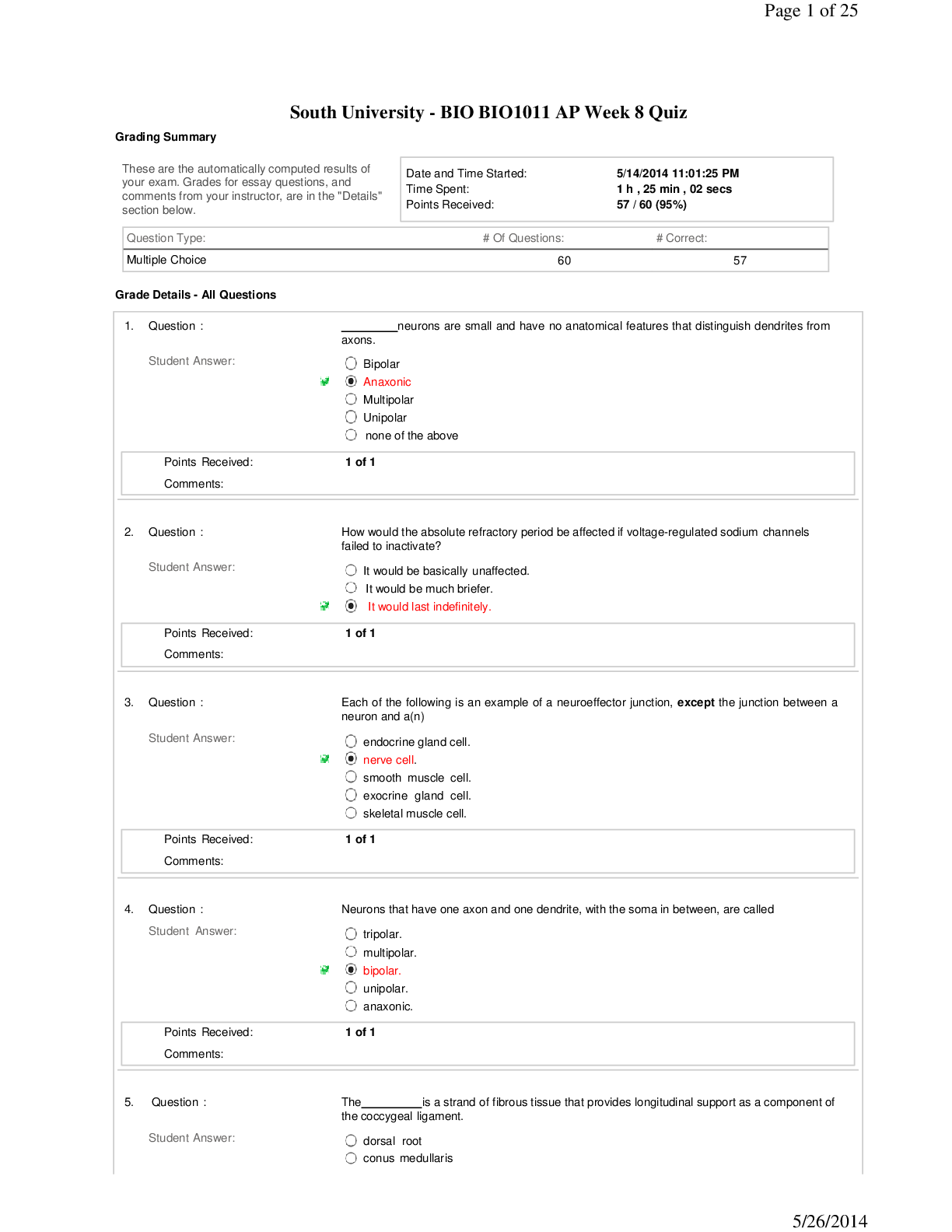
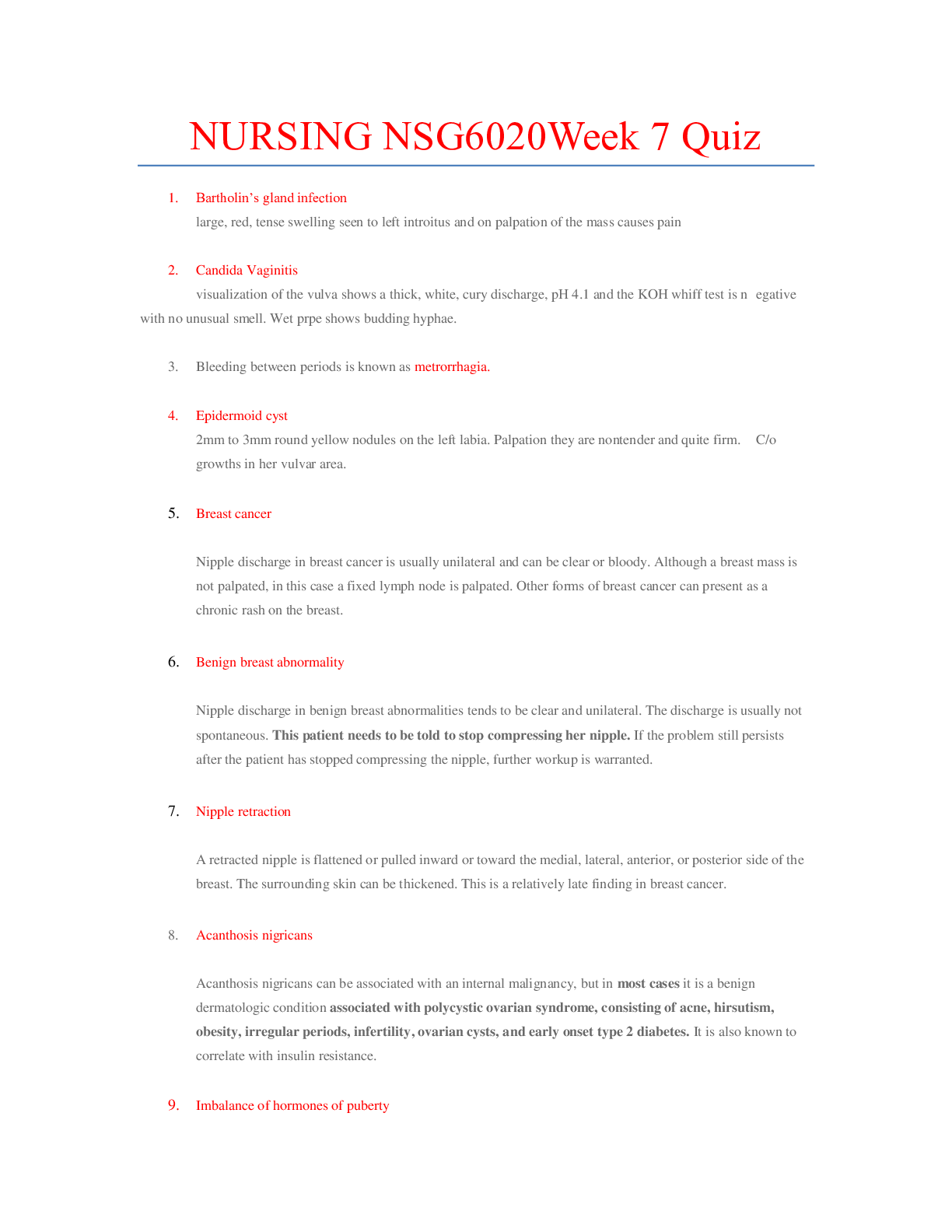
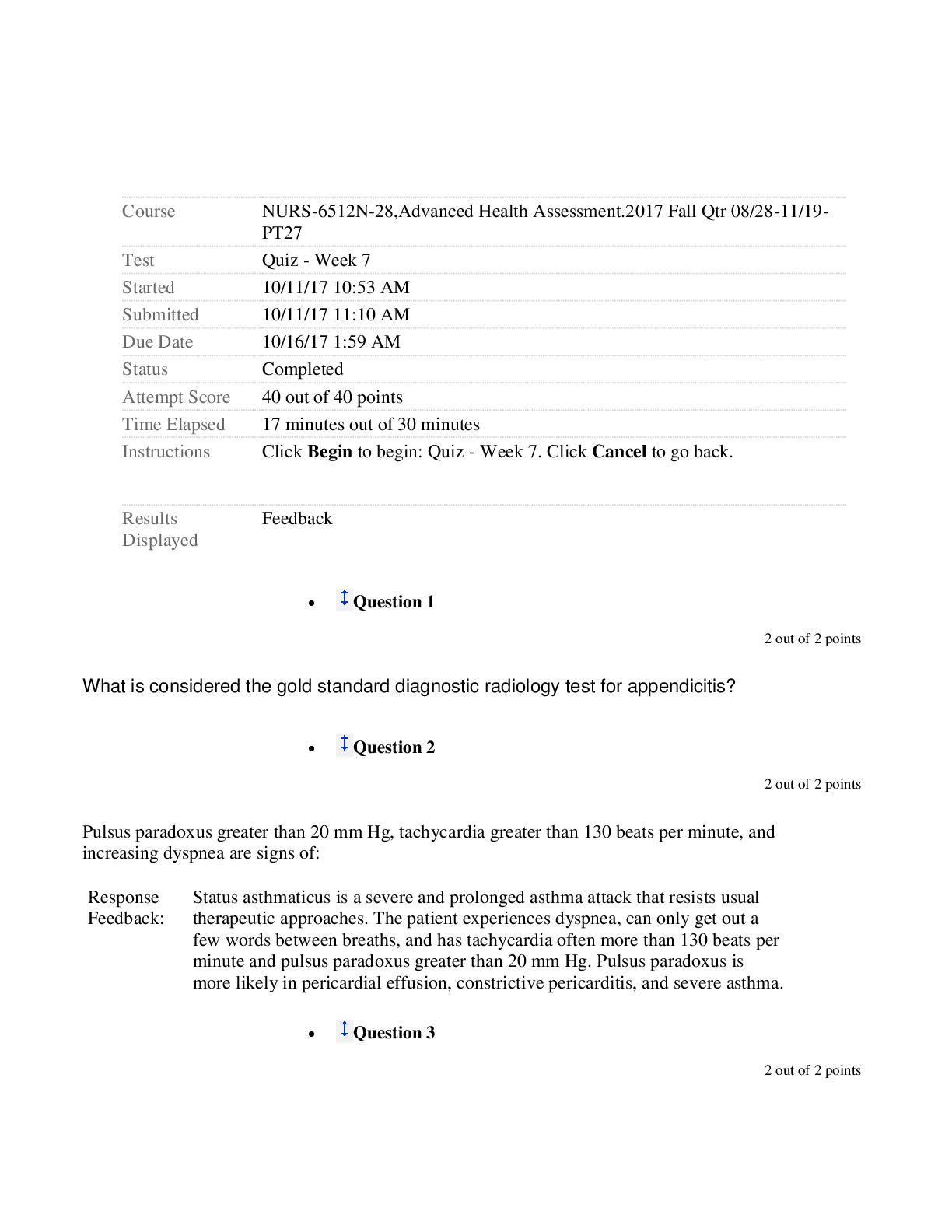



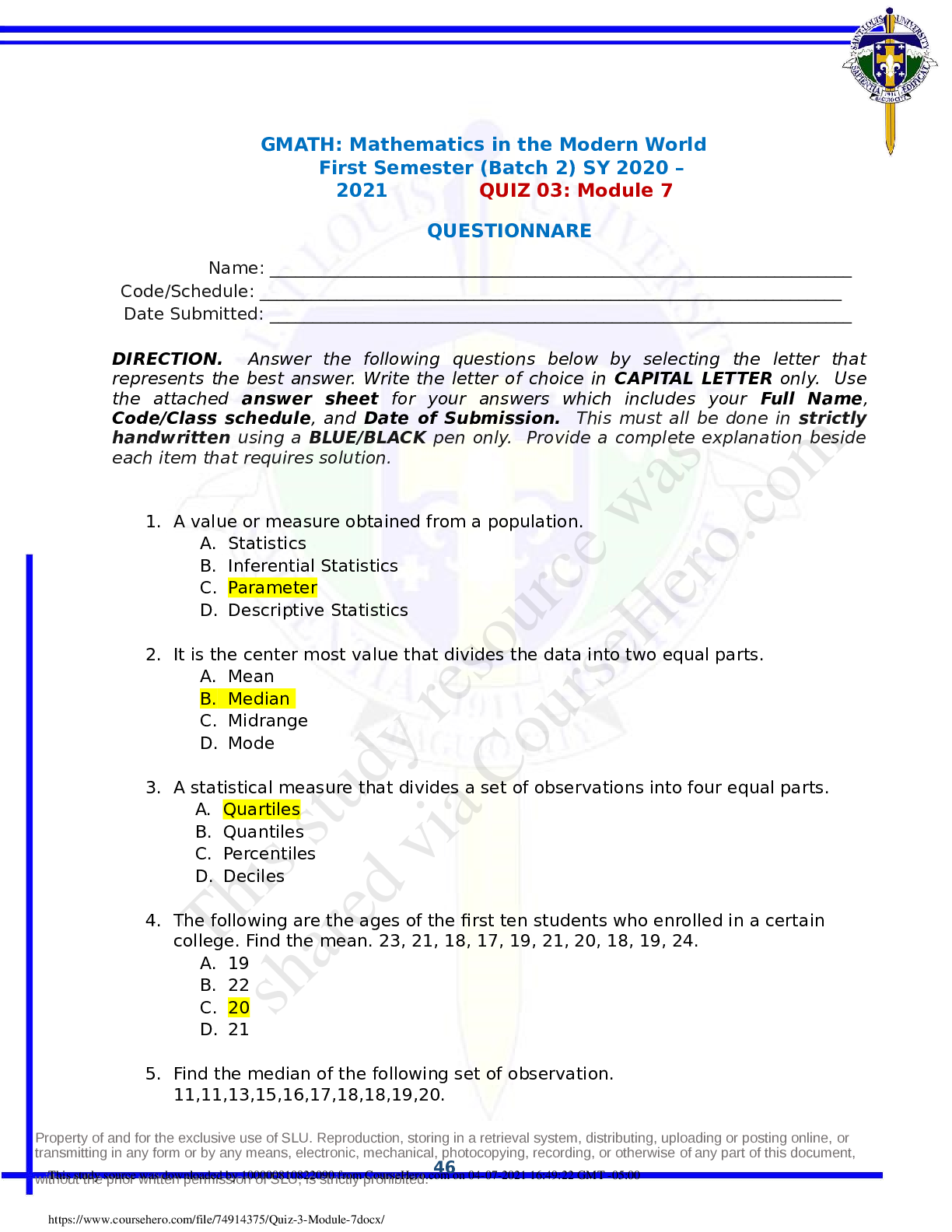



.png)




